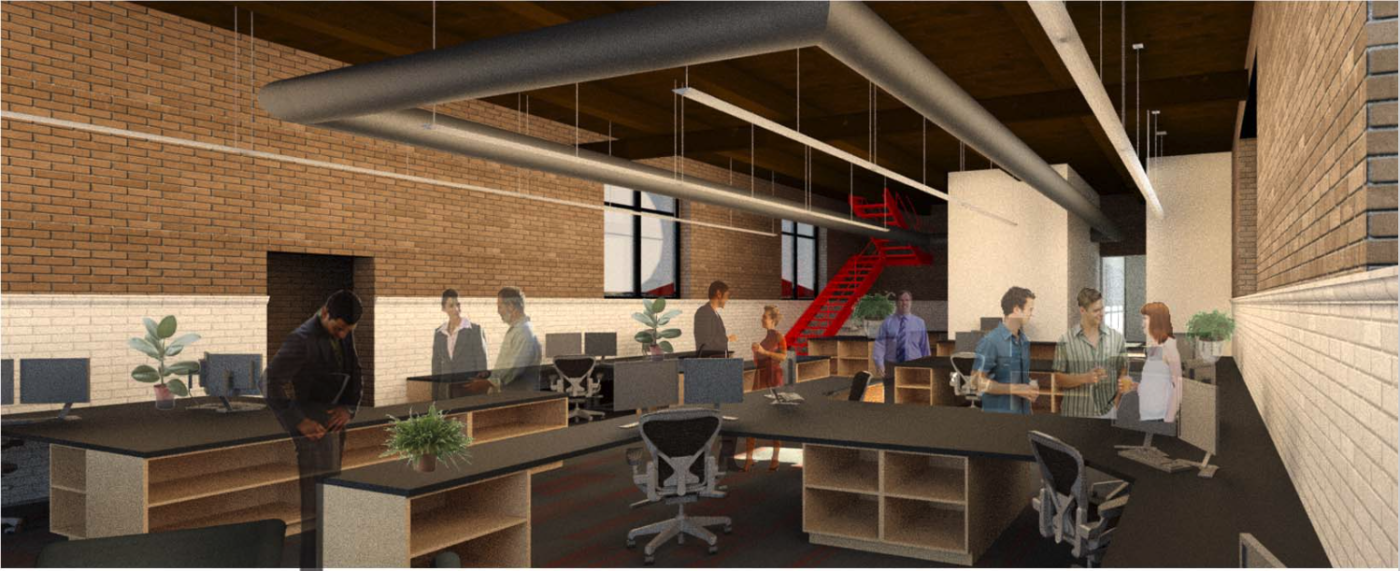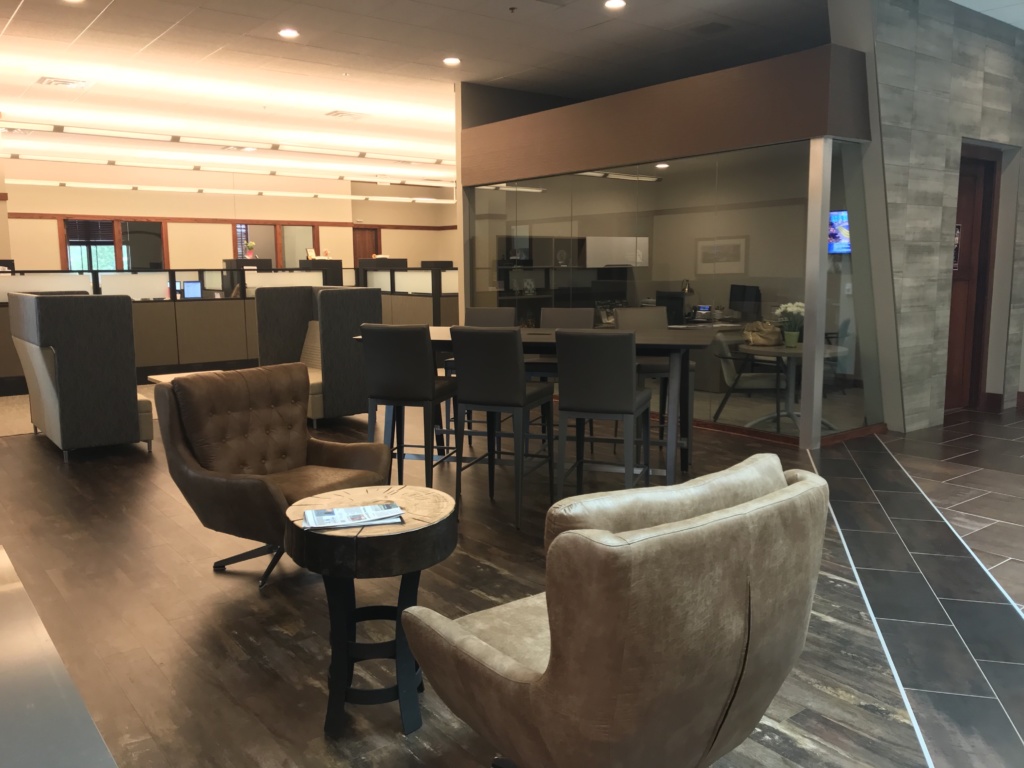Two years ago, I wrote a comprehensive article covering the state of co-working in Sioux Falls at the time. The Bakery, which was the largest standalone co-working space in Sioux Falls at the time, was on the verge of closing and Meso, another co-working space, had closed the year earlier. This left the Zeal Center for Entrepreneurship and a handful of smaller co-working spaces to meet the needs of solo-entrepreneurs and other remote employees in our city. There weren’t any major developments in the co-working industry in 2017 and 2018, but two new co-working spaces have popped up in 2019 in Sioux Falls. I thought it would be a good time to review these developments and evaluate the overall state of co-working in Sioux Falls.
Co-Working at Stone Group Architects

Late last year, Stone Group Architects announced that they were transforming an old fire station in Heritage Park into their office building, which would include co-working space on its second floor. Stone Group recently held a ribbon cutting for its new office space, which I had the opportunity to attend. They had about ten workspaces on their second floor, which appeared to be about half occupied. Their co-working space is somewhere between 1,000 and 2,000 square feet and has a mix of standalone executive suites and shared workspace areas. The price for a dedicated space ranges between $350.00 and $550.00 per month and is being marketed through NAI.
Co-Working at First Bank and Trust

First Bank and Trust (FB&T) also recently opened a co-working space in its 57th and Western branch. There is no cost to use FB&T’s co-working space and the bank hopes that the space will be “a more collaborative and personal environment for customers and employees.” The co-working space contains casual seating areas, a coffee and snack bar, and a community conference room that anyone can use to hold a meeting in. Individuals do not need to be FB&T customers to make use of the co-working space.
While FB&T is the only bank that offers a co-working space, it’s a safe bet that many banks will develop community-use spaces in the years to come. I’ve been told that the new First Premier building on 14th and Minnesota will have a community space that can be used for meetings and events and that another major Sioux Falls bank is eyeing a remodel and looking to repurpose some of its space toward community use. There’s strong competition in the Sioux Falls’ banking industry, and banks will increasingly turn to offering creative perks for its customers, such as community use space, to maintain market share.
Another Co-Working Space in the Works
There is also another co-working space and entrepreneurial development center that is in the early planning stages being organized by a group of Sioux Falls entrepreneurs. I am not personally involved with this project but have been told it will aim to serve historically underserved classes of entrepreneurs including women and minorities. This project may involve a major remodel of a building in downtown Sioux Falls. I don’t want to say too much else about this project, because it’s very early on in the discussion, it has not been publicly announced, and fundraising has not yet begun for this project.
Co-Working at Zeal

The Zeal Center for Entrepreneurship continues to offer co-working opportunities, executive suites and private offices for entrepreneurs. It has two tiers of co-working available at $99.00 and $249.00 per month. Zeal also has 27 private offices and 6 wet labs available for lease. The occupancy level for Zeal’s standalone offices and executive suites is the highest it’s been in the last several years thanks to demand from companies relocating to Sioux Falls and existing businesses seeking temporary office space. About 90% of the leasable office space at Zeal is being utilized. Zeal also has been averaging between 15 and 20 co-working members at any given time, which is well below its maximum capacity for co-working members.
Other Co-Working Opportunities
The Creative Co-Op and 927 Studios are two other small co-working spaces in Sioux Falls. Additionally, Regus offers executive suites for rent in the CNA Surety building in downtown Sioux Falls. Sioux Falls Ministry Center and Sioux Falls Seminary both rent out office space to ministry professionals and organizations that do not need a large standalone office space. Design House, which occupies the former Bakery space, is marketing itself as a co-working space for interior designers. And of course, downtown coffee shops continue to serve as functional co-working spaces for students, entrepreneurs and remote workers alike.
Is co-working still relevant to entrepreneurs in 2019?
While there are now many different flexible workspace options for remote workers and entrepreneurs to choose from, existing co-working spaces are largely underutilized. Zeal’s, FB&T’s and Stone Group’s co-working spaces are not operating near their maximum capacities. This suggests either these spaces don’t meet the needs of today’s entrepreneurs or there just aren’t that many entrepreneurs or remote workers seeking to work in a co-working space in Sioux Falls. The key advantages of using a co-working space, including high-speed Internet, printing services, meeting space, shared bathrooms, and shared kitchen space have either become ubiquitous or less relevant to modern entrepreneurs and remote workers.
Many entrepreneurs and remote workers (including my employees at MarketBeat) simply choose to work out of their homes and downtown coffee shops in lieu of utilizing a co-working space. It’s easy to see why, too. Working at home costs nothing, comes with no commute, and is usually free of distraction. When a remote worker or entrepreneur wants to socialize, they simply head to their favorite coffee shop with their laptop and begin working. Local coffee shops also offer many of the same benefits of co-working spaces (fast internet, meeting space, etc.) without the monthly cost of a co-working membership. Locally owned coffee shops are perceived to have a “cool factor” that co-working spaces lack, and you are much more likely to run into a friend or acquaintance at your favorite coffee shop than a relatively quiet co-working space.
How could co-working work in 2019 and beyond?
If someone wanted to build a successful co-working space in Sioux Falls that is relevant to today’s entrepreneur and is operationally feasible, I think it would need these ingredients:
- Be located downtown – Significant real-estate development has happened in downtown Sioux Falls in the last decade, and many local restaurants, coffee shops and boutiques have opened. It’s cool to be downtown, and entrepreneurs want to be downtown during the workday.
- Be subsidized by a government or large company – Co-Working spaces are generally not profitable businesses. Less than 40% of co-working spaces in the country make money, and those that are successful are usually backed by a large corporation, a university or a local government. Typically, entrepreneurs can’t afford the true operating cost of a co-working space, so there needs to be some outside funding to make co-working facilities financially feasible.
- Include a strong sense of community – Entrepreneurship is a lonely game and co-working spaces need to provide entrepreneurs a sense of community and the opportunity to make friends so that they know they’re not in it alone. The Bakery did this very well with its members-only events and community gatherings such as potlucks and “Free Friday’s” lunches. A new co-working successful space would need to have regular gatherings of its members to foster friendship and business collaboration so its members feel like they are part of a community and not just renters of office space.
- Include Event Space – Like every recurring revenue business, Co-Working spaces must deal with the problem of churn. As members drop off, co-working spaces need to find new members to replace them. By having an event space to hold educational and community events for entrepreneurs, a co-working space can sell itself to new potential members that attend the events at the co-working space. Entrepreneurs may also see educational and community events as a valuable reason to work at a co-working space in lieu of other commercial real-estate options.
- Be different than other commercial real-estate offerings. There’s office space of all shapes and sizes that can be rented in Sioux Falls. A community co-working space has to offer different types of spaces and lease terms to be successful. One of the reasons that people office out of Zeal is that it offers one-year renewable leases, which aren’t available in most traditional office spaces. I think a successful co-working space would have a mix of community workspace (which could double as event space), individual offices (or executive suites), and shared meeting space.
- Have a “Cool Factor.” If a co-working space is perceived as being too corporate, too bland, or too boring, no one will want to work there. For a co-working space to be successful, it must be at least as cool as a nice downtown coffee shop. Entrepreneurs often start businesses to get away from working in an office for a large business. If you build a co-working space that looks like the corporate office they used to work at, it’s unlikely to be appealing to entrepreneurs.
Wrap-up
There have been some encouraging developments for co-working in 2019, but I don’t know that any of the new co-working spaces will meet the needs of entrepreneurs or will be especially well utilized. I do think there’s still an opportunity for a sizable downtown co-working space, but we can’t expect it to operate profitably and it needs to really be something special that the entrepreneurial community can get behind.
